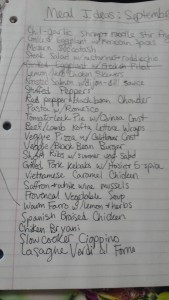Conscious meal planning can be one of the most successful ways to improve your diet and reduce monthly spending. For over a year now, we have been starting off every month with a single large, carefully planned grocery shopping trip. On this trip, we get all our protein, grains, shelf goods, and produce for the whole month. If you don’t hate grocery shopping as much as we do, this approach may not be the way you decide to go. But no matter if you are shopping for one month or one week, this can be a great approach to mindful eating.
Step One: Get inspired
It is easy to get into a rut when you are cooking most of your meals. This is where I find food magazines very helpful. Flip through food magazines, cruise your favorite cooking blog, listen to a podcast, and discuss with your family what they would like to see on the table that month. Write each idea down in a big list. This can include your go-to fast meals, also. (Quesadillas, Sandwiches, Fried rice, etc). Anything you want to make, write it down.
You are aiming for a good 20 (ish) meal ideas. You’ll probably not make some, and decide to make some not on the list, but that way you have a game plan for most nights that month. Plan to oversize some so that there are leftovers available. This is a very good time to discuss your eating out habits, and make a conscious decision about how many times a month you want to dine out. If its something your family really enjoys, you may decide that once or twice a week is what you want. What I find is that for us, it is mainly just for convenience. When I have dinners planned and all the ingredients in the fridge, it becomes much easier to get excited for what we have at home.
Here is an example of one of our meal lists, for September. Note, I was feeling uninspired, so most my ideas were taken from magazines. Most were a hit, though!
Step Two: Map your ingredients
Read through your meal list and write down a new list, for ingredients. As ingredients reoccur, make a note (x2, 5 lbs, etc) to increase the quantity. This is the step where you may decide to pare down your meal list to opt for more meals with similar ingredients. Buying “family packs” when you can really saves some dollars! If you are really on a tight budget, you can use this step to carefully plan the dollar total, look for coupons, and take out any luxury/non-essential items.
Step Three: Shop
I like to input our grocery list into an app, so we can divide and conquer at the store. We use Evernote, in which you are able to make lists, check off items, and it updates in real time. It is helpful to break your items down by department (Produce, Bulk, Frozen, etc) to be most efficient. Again, look for ingredients in the Bulk section or in family packs, these tend to be the best deals.
We do our big shopping trip at Whole Foods, but many items (plastic wrap, pet supplies, canned veggies) can be a bit cheaper at a different store. We usually check prices at Whole Foods, and leave some items for a quick run to Kroger later in the week. I know many people tend to see dollar signs when they hear the words “Whole Foods”, but it really isn’t as bad as they think. If you care about buying organic/more sustainable products, the prices really can’t be beat; especially meats, grains, and produce. Don’t get sucked into the specialty fancy vegan-seaweed chips or whatever- this is where they get your pocketbook.
Step Four: Enjoy!
The best part about meal planning is, of course, the food! It can be so fun and rewarding to challenge yourself to take an active role in the health of you and your family.
Take note of the ingredients that will go bad more quickly, and make those meals at the beginning of the month, leaving longer-storable produce meals for later. Produce that keeps a long time include cabbage, carrots, bell peppers, celery, potatoes, onions, radishes, apples, lemons, rutabaga, kohlrabi, beets. etc. If you notice that an ingredient is starting to turn past its prime, but won’t have time to use it right away, it takes only a few minutes to blanch and freeze it. Tomatoes and peppers do well frozen diced, with no blanching required.
Keep 1 or two proteins out for your first few meals, and freeze the rest. It is helpful to split “family packs” into individual servings- we do this with chicken breasts and thighs every grocery trip. It makes it super quick to grab out and throw in the fridge for dinner the next night.
If you can, I recommend taking a few hours on a Sunday night (or whenever you have time) to do some minor prep for the meals that week. Whether its making a big batch of bread dough, soaking beans, marinating proteins, chopping veggies, making stock, etc, you WILL appreciate it later. This sort of preparation makes weeknight cooking quick and stress-free. If it is a busy week, I like to have everything ready for a slow cooker meal I can throw together before I leave for work in the morning.
If I have one more tip, it is to give yourself license to stray from your meal list- often inspiration hits, and that is a great thing! The important part is that your kitchen is stocked with plenty of healthy, delicious ingredients, and you don’t have to go to the store again for a while!



